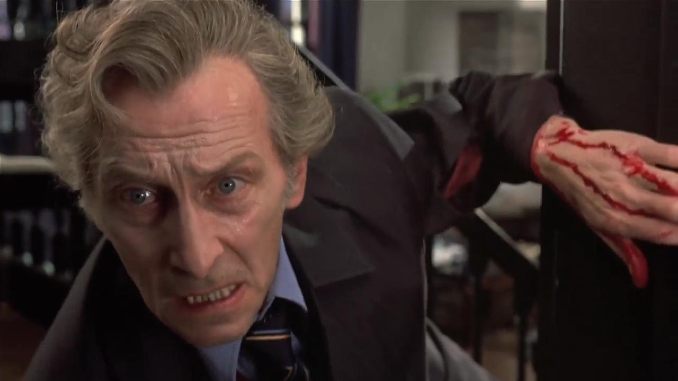Hammer Studios was far away from Hollywood, but the New Hollywood movement changed it all the same.
By the 1970s, the legendary British film studio that struck gold in the 1950s with a series of revamps of classic monster movies overflowing with bright red blood and cleavage had begun to decline. The movie landscape was shifting everywhere thanks to the 1960s and the dawn of films like Bonnie and Clyde and Easy Rider, and horror films were not exempt. Tastes had shifted through the psychological, slow-burn terror of Rosemary’s Baby and the DIY brutality of Night of the Living Dead. Hammer’s formula, while still effective to the devoted, wasn’t casting the same spell over the jaded general audience anymore.
So, the formula shifted. The violence got just a bit more graphic, and the once-suggested sexuality of early Hammer Horror shifted into full-on nudity with films like The Vampire Lovers and Twins of Evil. Eventually, even the tried-and-true 19th-century settings of most of Hammer’s best-known horror films went away, which brings us to the strange, uneven effort that is Dracula A.D. 1972.
In practice, Dracula A.D. 1972 is often as clunky as its title, but five decades after its release there’s a weird charm still hanging over the film and its mismatched elements. Hammer as the world knew it then didn’t really survive the 1970s, but after 50 years, this film and others like it stand as a testament to the bonkers ambition of a studio throwing everything at the wall to see what stuck, and that imbues the whole endeavor with a joyful, unpredictable charm.
Set 100 years after Lawrence Van Helsing killed Count Dracula in the midst of a thrilling carriage chase, A.D. 1972 picks up the action with Lorrimer Van Helsing (Cushing again, because the Van Helsing genes are just that strong) and his granddaughter Jessica (Stephanie Beacham) living a largely peaceful life in London. But because this is a Hammer movie, that peace is broken when Jessica’s friend Johnny Alucard (Christopher Neame) invites all of his pals to an occult ritual in an abandoned church. In a moment that echoes Hammer’s previous (and better) Dracula installment Taste the Blood of Dracula, Johnny uses the blood of one of his friends to summon none other than Dracula himself, setting the Count loose on unsuspecting Londoners.
The motivations here are obvious and straightforward: Dracula wants revenge on the Van Helsing dynasty, Van Helsing wants to protect his granddaughter and Alucard and his very subtle last name wants Dracula to make him into a vampire at last. It’s all fairly familiar territory for Hammer’s Dracula sequels, set apart by the modern setting, and so it’s easy to see why the film wasn’t necessarily well-received when it first hit theaters. With the benefit of hindsight, though, this merging of old and new help make A.D. 1972 and its eventual sequel, the much-better-titled The Satanic Rites of Dracula, gleefully weird and fun to watch.
Because it’s the first Hammer Dracula film to jump forward in the present while still following the Van Helsing family, A.D. 1972 has to answer a few key questions in the margins of its story. That means we get Cushing’s new and improved Van Helsing angrily defending his ancestors’ “conclusive” research into the nature of evil, as though there should be an entire Dracula Institute devoted to the study of vampires by now, and he’s very bitter that there isn’t. We also get Alucard pulling out Dracula’s signet ring from a hidden place in his swinging London bachelor pad, revealing that he’s somehow held onto an evil plan for a century while also becoming a Cool Guy who makes friends with hip Londoners in the early ‘70s. At one point, a fledgling vampire dies simply by falling into a shower, because the established mythology of the series holds that vampires are vulnerable to “running water.” At another, Cushing’s Van Helsing runs through London streets desperately looking for his granddaughter, and pauses to gawk at a department store mannequin in a window display. Then of course, there’s Lee’s Dracula, clearly out of place (he wasn’t fond of the modern update films) but trying to make the most of this world of acoustic guitars, wild décor and a new servant who can’t seem to get anything right.
Sure, it doesn’t always work, but even watching it 50 years later, there’s an undeniable freshness to the energy of Dracula A.D. 1972, something it shares with fellow latter-day Hammer horror efforts like Blood from the Mummy’s Tomb, Dr. Jekyll and Sister Hyde and the truly bonkers The Legend of the 7 Golden Vampires (Hammer meets the Shaw Brothers). In the 1950s, when Hammer launched its new wave of monster films with Curse of Frankenstein and Horror of Dracula, it did so with bright, bloody fury, infusing stories we previously only knew in black-and-white with glorious, sexy color shot through with monstrous new creatures. It was a certain kind of lightning in a bottle that the studio would never, could never recapture, but in the 1970s Hammer was at least trying to get there again. They were reaching with all their might for some kind of new energy, and there’s still something deeply appealing about that effort. The latter days of Hammer’s original era will never carry the same aura as the heyday of Hammer Horror, but with the kindness of time, those films have cast a spell all their own.
Matthew Jackson is a pop culture writer and nerd-for-hire who’s been writing about entertainment for more than a decade. His writing about movies, TV, comics, and more regularly appears at SYFY WIRE, Looper, Mental Floss, Decider, BookPage, and other outlets. He lives in Austin, Texas, and when he’s not writing he’s usually counting the days until Christmas.
